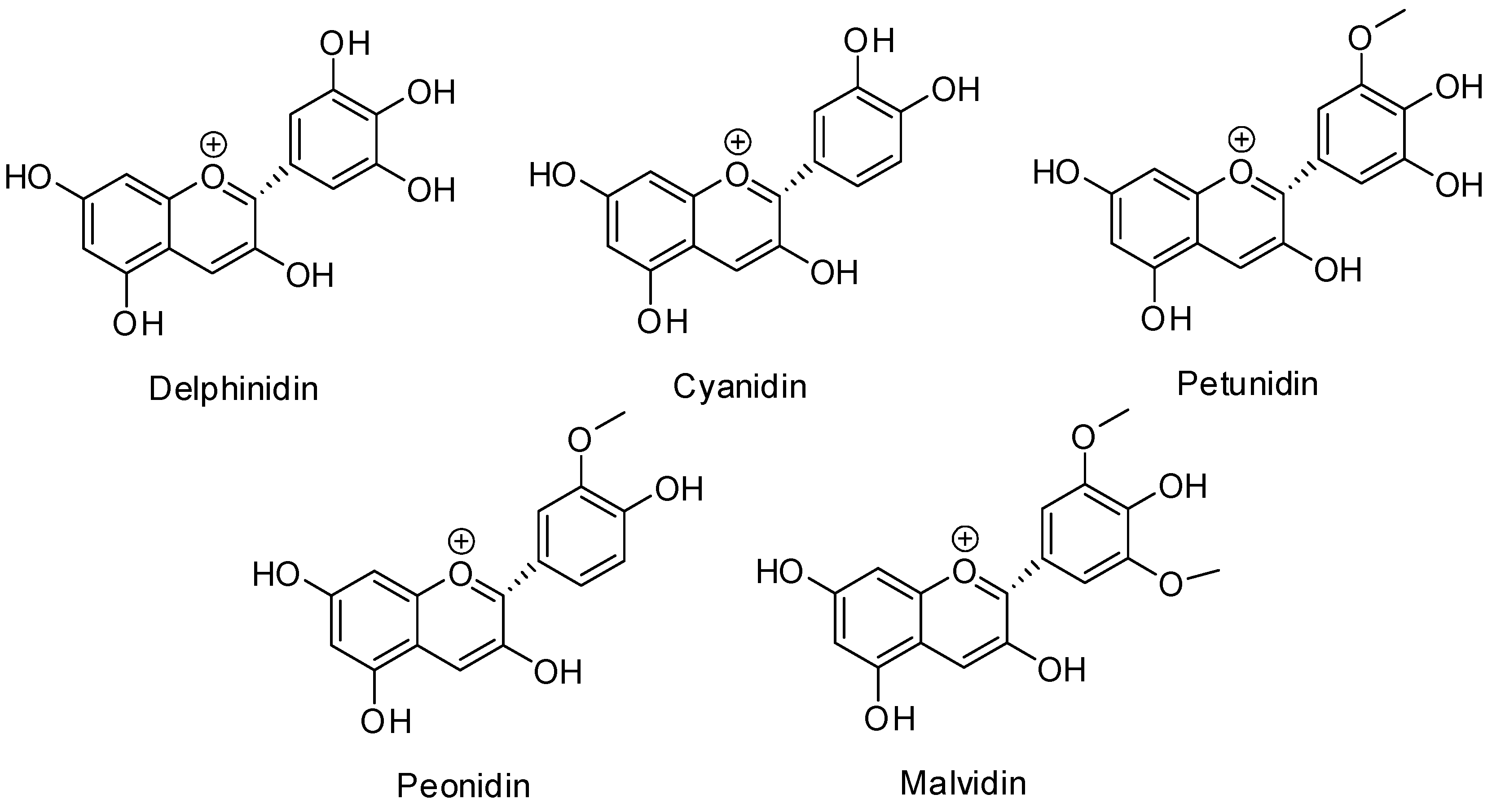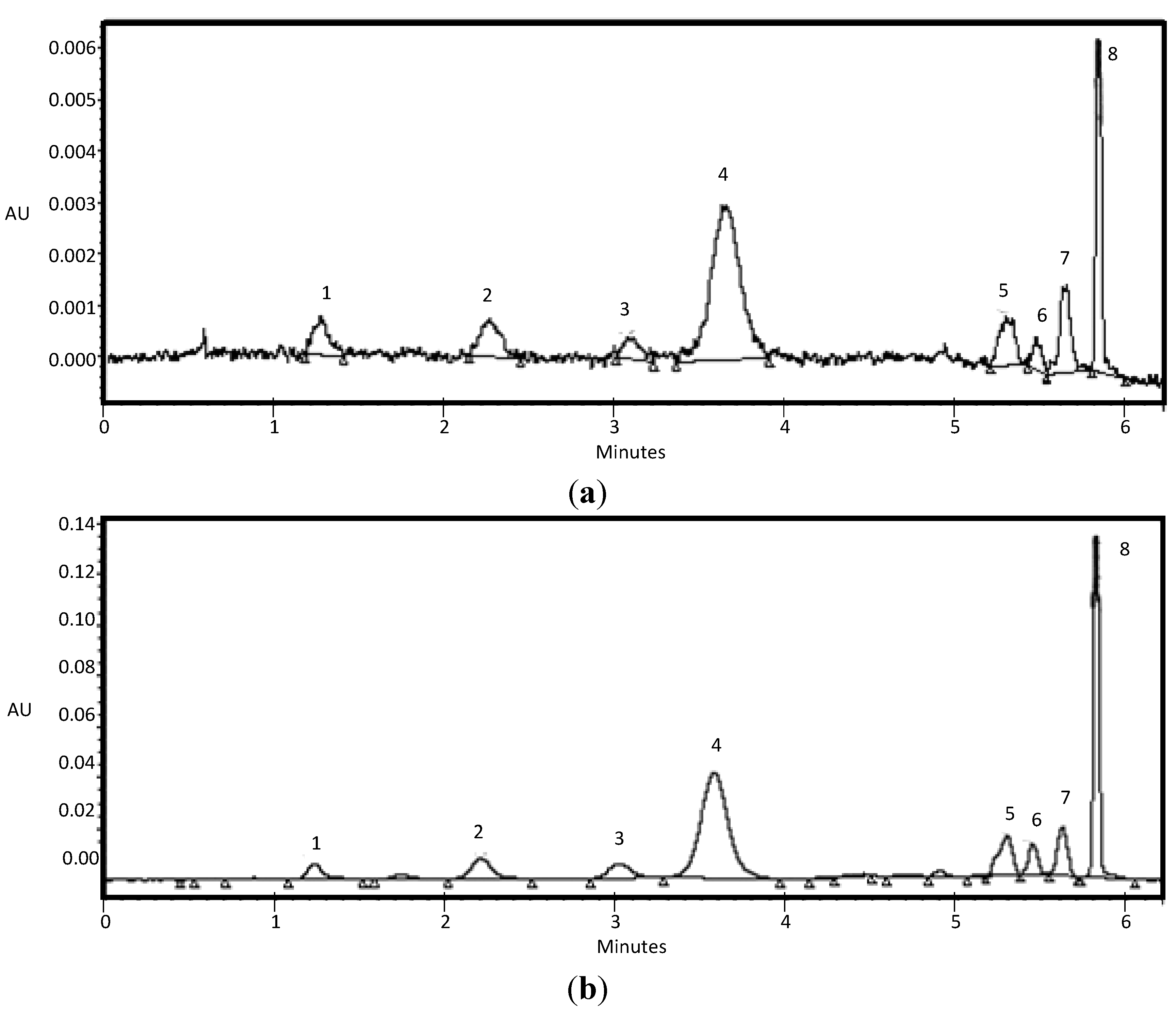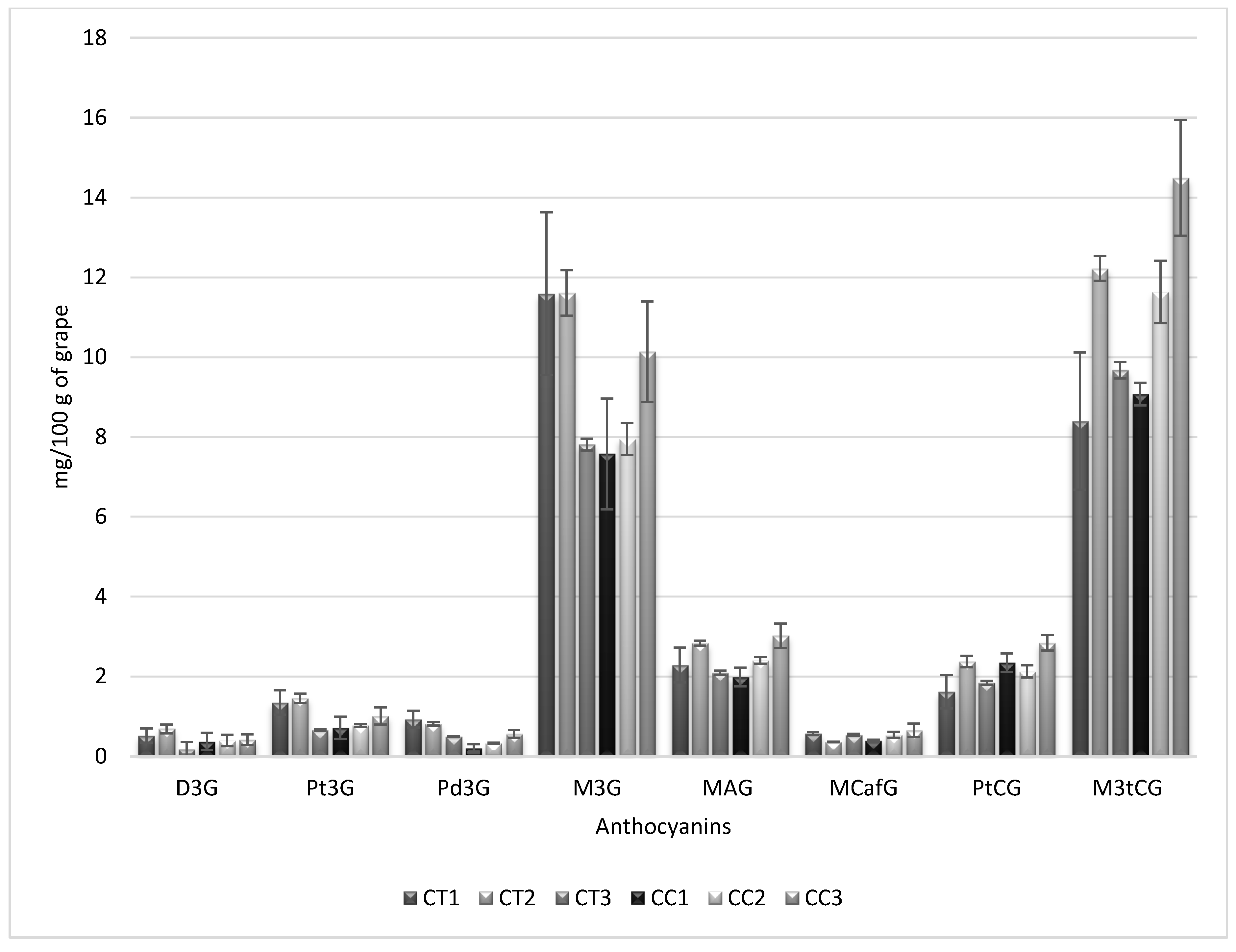A New Solid Phase Extraction for the Determination of Anthocyanins in Grapes
Abstract
:1. Introduction

2. Results and Discussion
2.1. Comparison of SPE Cartridges
| Solid Phase | Steps | Relative Anthocyanins Concentration (% ± RSD) | ||||||||
|---|---|---|---|---|---|---|---|---|---|---|
| D3G | Pt3G | Pd3G | M3G | PtAG | MAG | MCafG | PtCG | M3tCG | ||
| DSC-18 | Sample residue | 23.6 ± 10.9 | 19.1 ± 7.8 | - | 10.3 ± 4.1 | - | - | - | - | - |
| Wash residue | - | - | - | - | - | - | - | - | - | |
| Recovery | 7.3 ± 0.2 | 6.5 ± 0.1 | 39.9 ± 22.0 | 16.2 ± 3.0 | 49.0 ± 6.3 | 19.2 ± 1.4 | 71.0 ± 4.0 | 59.1 ± 11.6 | 31.5 ± 1.2 | |
| VC-18 | Sample residue | 34.7 ± 8.8 | 43.6 ± 1.2 | - | 23.48 ± 0.1 | - | - | - | - | - |
| Wash residue | - | - | - | - | - | - | - | - | - | |
| Recovery | 3.6 ± 5.1 | 3.7 ± 5.2 | - | 10.7 ± 0.5 | 70.7 ± 28.1 | 46.1 ± 0.8 | 85.9 ± 7.1 | 69.9 ± 13.5 | 33.1 ± 1.8 | |
| VEN | Sample residue | 29.6 ± 2.7 | 30.6 ± 11.5 | - | 22.2 ± 0.7 | - | - | - | - | - |
| Wash residue | - | - | - | - | - | - | - | - | - | |
| Recovery | - | - | - | 15.2 ± 1.1 | 54.8 ± 9.9 | 38.0 ± 0.4 | 67.9 ± 0.4 | 58.1 ± 3.4 | 34.4 ± 1.2 | |
| Strata X | Sample residue | - | - | - | - | - | - | - | - | - |
| Wash residue | - | - | - | - | - | - | - | - | - | |
| Recovery | 44. 7 ± 7.4 | 55.9 ± 1.8 | 88.7 ± 0.2 | 44.0 ± 1.1 | 24.5 ± 3.5 | 27.6 ± 0.2 | 47.7 ± 2.1 | 55.1 ± 5.0 | 23.6 ± 3.3 | |
| EN | Sample residue | - | - | - | - | - | - | - | - | - |
| Wash residue | - | - | - | - | - | - | - | - | - | |
| Recovery | 19.2 ± 0.3 | 23.3 ± 1.6 | - | 33.2 ± 0.6 | 47.7 ± 0.8 | 35.6 ± 0.4 | 62.44 ± 1.8 | 52.5 ± 1.7 | 18.6 ± 0.0 | |
2.2. Sample Loading Flow Rate
| Sample Loading Flow (mL·min−1) | Relative Anthocyanins Concentration (% ± RSD) | ||||
|---|---|---|---|---|---|
| M3G | PtAG | MAG | PtCG | M3tCG | |
| 15 | 102.6 ± 11.3 | 114.6 ± 14.5 | 118.9 ± 3.8 | 104.3 ± 5.1 | 116.4 ± 3.1 |
| 20 | 109.3 ± 8.7 | 113.2 ± 0.5 | 108.9 ± 4.9 | 108.6 ± 4.4 | 95.2 ± 5.6 |
| 25 | 96.3 ± 12.4 | 97.8 ± 3.4 | 98.7 ± 1.8 | 97.0 ± 1.6 | 85.6 ± 2.8 |
2.3. Amount of Eluting Solvent
| Elution Solvent | Relative Anthocyanins Concentration (% ± RSD) | |||||
|---|---|---|---|---|---|---|
| Elution Volume | M3G | PtAG | MAG | PtCG | M3tCG | |
| MeOH pH = 2 | 1 mL | 111.3 ± 6.5 | 96.1 ± 2.5 | 70.4 ± 25.8 | 37.1 ± 64.1 | 31.6 ± 70.3 |
| 1.5 mL | 106.8 ± 10.8 | 97.0 ± 1.8 | 103.0 ± 0.8 | 118.2 ± 10.8 | 105.6 ± 7.4 | |
| MeOH pH = 1.5 | 1mL | 90.8 ± 9.0 | 83.9 ± 7.0 | 48.4 ± 22.0 | 24.7 ± 27.5 | 21.3 ± 18.4 |
| 1.5 mL | 92.8 ± 1.8 | 102.2 ± 3.1 | 104.8 ± 6.1 | 77.1 ± 4.2 | 87.8 ± 6.3 | |
| MeOH pH = 1 | 1 mL | 100.7 ± 3.8 | 100.2 ± 38.0 | 52.3 ± 77.2 | 21.0 ± 30.9 | 19.9 ± 10.8 |
| 1.5 mL | 81.7 ± 29.1 | 97.6 ± 19.8 | 89.5 ± 44.5 | 82.4 ± 20.3 | 72.2 ± 48.1 | |

2.4. Repeatability and Intermediate Precision
2.5. Application to Real Samples


3. Experimental Section
3.1. Chemicals and Solvents
3.2. Grape Samples
3.3. Extraction Procedure
3.4. Solid Phase Extraction
| Commercial Brand | Abbreviation | Solid Phase | Amount of Solid Phase (mg) | Supplier |
|---|---|---|---|---|
| Discovery DSC-18 | DSC-18 | Octadecyl silica | 500 | Supelco |
| Bond Elut C-18 | VC-18 | Octadecyl silica | 500 | Varian |
| Bond Elut ENV | VEN | Styrene-divinylbenzene | 200 | Varian |
| Strata X | Strata X | Modified divinylbenzene | 200 | Phenomenex |
| LiChrolut EN | EN | Ethyl-vinyl-benzene styrene-divinylbenzene | 200 | Merck |
3.5. Ultra-Performance Liquid Chromatography (UPLC)
4. Conclusions
Acknowledgments
Author Contributions
Conflicts of Interest
References
- Yoo, M.-A.; Kim, J.-S.; Chung, H.-K.; Park, W.-J.; Kang, M.-H. The antioxidant activity of various cultivars of grape skin extract. Food Sci. Biotechnol. 2007, 16, 884–888. [Google Scholar]
- He, F.; Mu, L.; Yan, G.-L.; Liang, N.-N.; Pan, Q.-H.; Wang, J.; Reeves, M.J.; Duan, C.-Q. Biosynthesis of anthocyanins and their regulation in colored grapes. Molecules 2010, 15, 9057–9091. [Google Scholar] [CrossRef] [PubMed]
- Guerrero, R.F.; Liazid, A.; Palma, M.; Puertas, B.; Gonzalez-Barrio, R.; Gil-Izquierdo, A.; Garcia-Barroso, C.; Cantos-Villar, E. Phenolic characterisation of red grapes autochthonous to Andalusia. Food Chem. 2008, 112, 949–955. [Google Scholar] [CrossRef]
- Downey, M.O.; Dokoozlian, N.K.; Krstic, M.P. Cultural practice and environmental impacts on the flavonoid composition of grapes and wines: A review of recent research. Am. J. Enol. Vitic. 2006, 57, 257–268. [Google Scholar]
- Segade, S.R.; Vazquez, E.S.; Orriols, I.; Giacosa, S.; Rolle, L. Possible use of texture characteristics of winegrapes as markers for zoning and their relationship with anthocyanin extractability index. Int. J. Food Sci. Technol. 2011, 46, 386–394. [Google Scholar] [CrossRef]
- Gawel, R. Red wine astringency: A review. Aust. J. Grape Wine Res. 1998, 4, 74–95. [Google Scholar] [CrossRef]
- Santos-Buelga, C.; Scalbert, A. Proanthocyanidins and tannin-like compounds—Nature, occurrence, dietary intake and effects on nutrition and health. J. Sci. Food Agric. 2000, 80, 1094–1117. [Google Scholar] [CrossRef]
- Carrera, C.; Ruiz-Rodriguez, A.; Palma, M.; Barroso, C.G. Ultrasound assisted extraction of phenolic compounds from grapes. Anal. Chim. Acta 2012, 732, 100–104. [Google Scholar] [CrossRef] [PubMed]
- Puoci, F.; Curcio, M.; Cirillo, G.; Iemma, F.; Spizzirri, U.G.; Picci, N. Molecularly imprinted solid-phase extraction for cholesterol determination in cheese products. Food Chem. 2007, 106, 836–842. [Google Scholar] [CrossRef]
- Grigoriadou, D.; Androulaki, A.; Psomiadou, E.; Tsimidou, M.Z. Solid phase extraction in the analysis of squalene and tocopherols in olive oil. Food Chem. 2007, 105, 675–680. [Google Scholar] [CrossRef]
- Zhu, Y.; Chiba, K. Determination of cadmium in food samples by ID-ICP-MS with solid phase extraction for eliminating spectral-interferences. Talanta 2012, 90, 57–62. [Google Scholar] [CrossRef] [PubMed]
- Tian, M.; Li, S.; Row, K. Molecularly imprinted polymer for solid-phase extraction of ecteinascidin 743 from sea squirt. Chin. J. Chem. 2012, 30, 43–46. [Google Scholar] [CrossRef]
- Erdogan, H.; Yalcinkaya, O.; Tuerker, A.R. Determination of inorganic arsenic species by hydride generation atomic absorption spectrometry in water samples after preconcentration/separation on nano ZrO2/B2O3 by solid phase extraction. Desalination 2011, 280, 391–396. [Google Scholar] [CrossRef]
- He, J.; Giusti, M.M. High-purity isolation of anthocyanins mixtures from fruits and vegetables—A novel solid-phase extraction method using mixed mode cation-exchange chromatography. J. Chromatogr. A 2011, 1218, 7914–7922. [Google Scholar] [CrossRef] [PubMed]
- Martí, M.-P.; Pantaleon, A.; Rozek, A.; Soler, A.; Valls, J.; Macia, A.; Romero, M.-P.; Motilva, M.-J. Rapid analysis of procyanidins and anthocyanins in plasma by microelution SPE and ultra-HPLC. J. Sep. Sci. 2010, 33, 2841–2853. [Google Scholar] [CrossRef] [PubMed]
- Rostagno, M.A.; Palma, M.; Barroso, C.G. Solid-phase extraction of soy isoflavones. J. Chromatogr. A 2005, 1076, 110–117. [Google Scholar] [CrossRef] [PubMed]
- Romero-Cascales, I.; Ortega-Regules, A.; Lopez-Roca, J.M.; Fernandez-Fernandez, J.I.; Gomez-Plaza, E. Differences in anthocyanin extractability from grapes to wines according to variety. Am. J. Enol. Vitic. 2005, 56, 212–219. [Google Scholar]
- Peña-Neira, A.; Caceres, A.; Pastenes, C. Low molecular weight phenolic and anthocyanin composition of grape skins from cv.syrah (Vitis vinifera L.) in the maipo valley (Chile): Effect of clusters thinning and vineyard yield. Food Sci. Technol. Int. 2007, 13, 153–158. [Google Scholar]
- Diago, M.P.; Vilanova, M.; Blanco, J.A.; Tardaguila, J. Effects of mechanical thinning on fruit and wine composition and sensory attributes of Grenache and Tempranillo varieties (Vitis vinifera L.). Aust. J. Grape Wine Res. 2010, 16, 314–326. [Google Scholar] [CrossRef]
- Zalamena, J.; Cassol, P.C.; Brunetto, G.; Panisson, J.; Marcon, J.L.; Schlennper, C. Productivity and composition of grapes and wine of vines intercropped with cover crops. Pesqui. Agropecu. Bras. 2013, 48, 182–189. [Google Scholar] [CrossRef]
- Wheeler, S.J.; Black, A.S.; Pickering, G.J. Vineyard floor management improves wine quality in highly vigorous Vitis vinifera “Cabernet Sauvignon” in New Zealand. N. Z. J. Crop Hortic. Sci. 2005, 33, 317–328. [Google Scholar] [CrossRef]
- Lopes, C.M.; Monteiro, A.; Machado, J.P.; Fernandes, N.; Araujo, A. Cover cropping in a sloping non-irrigated vineyard: II—Effects on vegetative growth, yield, berry and wine quality of “Cabernet Sauvignon” grapevines. Cienc. Tec. Vitivinic. 2008, 23, 37–43. [Google Scholar]
- Jeffery, D.W.; Mercurio, M.D.; Herderich, M.J.; Hayasaka, Y.; Smith, P.A. Rapid isolation of red wine polymeric polyphenols by solid-phase extraction. J. Agric. Food Chem. 2008, 56, 2571–2580. [Google Scholar] [CrossRef] [PubMed]
- Sample Availability: Not available.
© 2014 by the authors. Licensee MDPI, Basel, Switzerland. This article is an open access article distributed under the terms and conditions of the Creative Commons Attribution license ( http://creativecommons.org/licenses/by/4.0/).
Share and Cite
Ferreiro-González, M.; Carrera, C.; Ruiz-Rodríguez, A.; Barbero, G.F.; Ayuso, J.; Palma, M.; Barroso, C.G. A New Solid Phase Extraction for the Determination of Anthocyanins in Grapes. Molecules 2014, 19, 21398-21410. https://doi.org/10.3390/molecules191221398
Ferreiro-González M, Carrera C, Ruiz-Rodríguez A, Barbero GF, Ayuso J, Palma M, Barroso CG. A New Solid Phase Extraction for the Determination of Anthocyanins in Grapes. Molecules. 2014; 19(12):21398-21410. https://doi.org/10.3390/molecules191221398
Chicago/Turabian StyleFerreiro-González, Marta, Ceferino Carrera, Ana Ruiz-Rodríguez, Gerardo F. Barbero, Jesús Ayuso, Miguel Palma, and Carmelo G. Barroso. 2014. "A New Solid Phase Extraction for the Determination of Anthocyanins in Grapes" Molecules 19, no. 12: 21398-21410. https://doi.org/10.3390/molecules191221398






